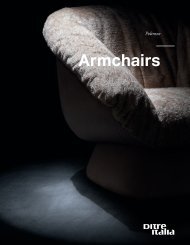LADIVA katalog FAMILY GRES FLOOR
włoskie płytki ceramiczne
włoskie płytki ceramiczne
Create successful ePaper yourself
Turn your PDF publications into a flip-book with our unique Google optimized e-Paper software.
Colori, senza tempo<br />
Colors, timeless<br />
Colori Ladiva. La nostra scala colori, parte da concetti basici.<br />
Personalmente ho creato la scala colori, cercando di prendere quello che<br />
madre natura ci propone, perché per me un<br />
interno, deve essere parte integrante dell’esterno e al<br />
mondo che ci circonda.La somma dei colori, quindi, genera<br />
il bianco e per cui si parla di sintesi additiva, questo è<br />
stato il primo colore che ho scelto. Il nostro bianco:<br />
Ladiva Colors. Our shade guide starts from basic concepts.<br />
Personally I created the shade guide, trying to take what mother nature<br />
offers us, because for me an<br />
internal, must be an integral part of the exterior and all<br />
world that surrounds us. The sum of the colors,<br />
therefore, generates white and for which we speak of additive synthesis,<br />
this is it was the first color I chose. Our white:<br />
RGB<br />
SINTESI ADDITIVA<br />
FONTI DI LUCE<br />
Opposta alla sintesi additiva, c’è la sottrattiva e quindi il colore nero. Il<br />
nostro nero<br />
RGB<br />
ADDITIVE SUMMARY<br />
SOURCES OF LIGHT<br />
Opposite to additive synthesis, there is the subtractive and<br />
therefore the black color. Our black<br />
RGB<br />
SINTESI ADDITIVA<br />
FONTI DI LUCE<br />
Con questi 2 colori, ho ottenuto la prima gamma colori dal bianco al nero<br />
in 8 gradazioni, facendo attenzione a non cadere<br />
nell’errore di creare dei toni freddi, quindi lavorando con le solite basi di<br />
rosso, blu e verde e dei suoi derivati.<br />
La stretta parentela del marrone con il grigio fa sì che sia un colore<br />
difficile da creare, spesso il marrone viene anche<br />
chiamato come “Grigio Sbagliato”.<br />
Regolare le proporzioni di tre ingredienti, rende il gioco<br />
complicato, soprattutto perché si rischia, ad ogni errore, di<br />
ricadere in un grigiastro senza carattere, simile a quello già<br />
fatto nella prima scala colori.<br />
Ottenuto il nostro marrone, abbiamo miscelato lo stesso con il bianco che<br />
avevamo in precedenza, correggendo nelle<br />
8 tonalità il colore ottenuto. Questa scala colori dall’avorio al marrone,<br />
ha il fascino di non avere quell’effetto di tono caldo.<br />
Quando parliamo di colore nel senso percettivo,<br />
non è facile descriverlo con esattezza.<br />
Un fisico potrebbe descrivere l’onda,<br />
con la sua lunghezza e la sua frequenza,<br />
ma artisti, grafici e designer utilizzano altri parametri,<br />
io personalmente ho cercato di creare una scala cromatica<br />
in linea con il mio concetto di piastrelle, dove quello<br />
che per me conta è che il prodotto non stanchi mai e non<br />
“invecchi mai”. Ho scelto infatti un sistema a decoro tattile<br />
( rilievo ) perché in base al punto luce ha sempre riflessioni<br />
diverse ed aggiunto dei colori basici come sopra descritto sulla superficie.<br />
Con questo sistema, spero di aver dato ad ogni<br />
architetto designer ed artista d’interni, la possibilita’ di<br />
spaziare con qualsiasi cosa sia di loro gradimento dopo,<br />
perché la mia ceramica ed il mio colore sono da ritenersi un<br />
involucro neutro, un foglio di carta bianca.<br />
Ladiva, NEVER GETS OLD, Fabio Pesce<br />
RGB<br />
ADDITIVE SUMMARY<br />
SOURCES OF LIGHT<br />
With these 2 colors, I got the first color range from white to black in 8<br />
shades, being careful not to fall out in the error of creating cold tones,<br />
then working with the usual bases of red, blue and green and its derivatives.<br />
The close relationship of brown with gray makes it a difficult<br />
color to create, often brown also comes<br />
called as “Wrong Gray”.<br />
Adjusting the proportions of three ingredients makes the<br />
game complicated, above all because you risk, with every<br />
mistake, of falling back into a characterless grayish,<br />
similar to that already done in the first shade guide.<br />
Having obtained our brown, we mixed the same with the<br />
white we had previously, correcting in the 8 shades the color obtained.<br />
This color scale from ivory to brown has charm<br />
not to have that warm tone effect.<br />
When we talk about color in the perceptual sense,<br />
it is not easy to describe it exactly. A physicist could describe the wave,<br />
with its length and frequency, but artists, graphic designers and designers<br />
use other parameters, I personally tried to create a chromatic scale<br />
in line with my concept of tiles, where that<br />
what counts for me is that the product never gets tired and never<br />
“Never gets old”. In fact, I chose a tactile decoration system<br />
(relief) because according to the light point it always has reflections<br />
different and added basic colors as described above on the<br />
surface. With this system, I hope I have given each<br />
architect designer and interior artist, the possibility of<br />
range with whatever they like after,<br />
because my ceramic and my color are to be considered a<br />
neutral wrapper, a sheet of white paper.<br />
Ladiva, NEVER GETS OLD, Fabio Pesce

















